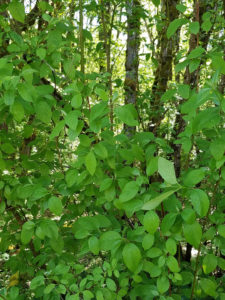 Red Osier Dogwood, Cornus stolonifera
Red Osier Dogwood, Cornus stolonifera
Cornaceae – Dogwood family
The interesting origins of the generic name “Cornus” and the common name “dogwood” are explained in the section on pacific dogwood. The adjectives “creek” and “red osier” of the common name accurately describe the wet or damp soil conditions preferred by this dogwood, and the willow-like (“osier” of French origin) stems that turn bright red in winter. The tendency for prostrate stems (stolons) to sprout roots enables the creek dogwood to have a spreading, sometimes thicket-like habit of growth, and is the origin of the specific name “stolonifera.”
The Red Osier dogwood has opposite, ovate leaves, and clusters of tiny four-petaled flowers like its cousin the Pacific dogwood. However, the Red Osier dogwood lacks the large, showy, petal-like bracts of the Pacific dogwood. The landscaping virtues of this native dogwood are most striking in late fall and winter, when clusters of white berries contrast aesthetically with smooth and naked stems of red. A vintage winter scene will have fresh-fallen snow as the backdrop of white for the red-osier stems.
In wet areas, Red Osier dogwood is a rapid grower reaching 6 to 12 feet within a few years. Birds find the fruit attractive, and seem quite successful in dispersing the seeds around neighborhoods and wet areas. Although bitter, the berries were used as food by certain Native groups. The flexible stems were used to make racks, bows, and baskets. Bark fibers were processed into cordage for tying (5-25).
Information courtesy of “The View From Springbrook Park; an Illustrated Natural History” by Ed Chinn.
Photos taken by Laura Tanz
Sponsored by Friends of Springbrook Park; Lake Oswego, OR